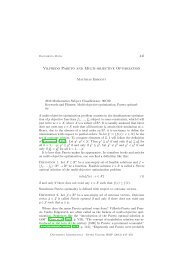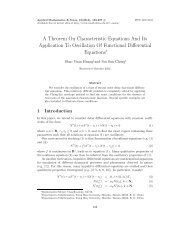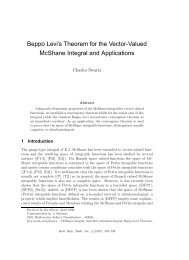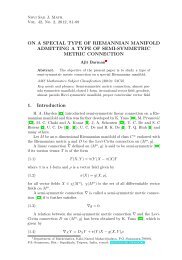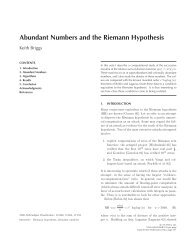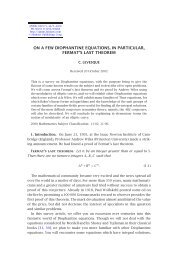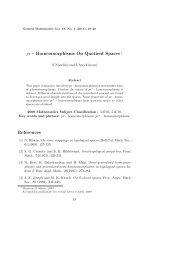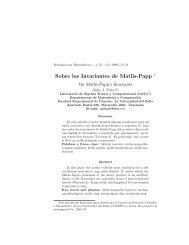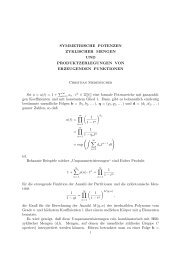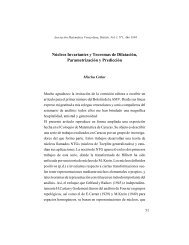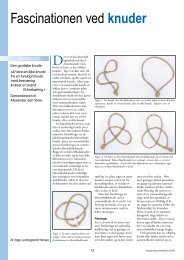An Essay in European Ethnomathe - European Mathematical Society
An Essay in European Ethnomathe - European Mathematical Society
An Essay in European Ethnomathe - European Mathematical Society
Create successful ePaper yourself
Turn your PDF publications into a flip-book with our unique Google optimized e-Paper software.
ZDM 99/2 <strong>An</strong>alyses<br />
<strong>An</strong> <strong>Essay</strong> <strong>in</strong> <strong>European</strong> <strong>Ethnomathe</strong>matics:<br />
The Social and Cultural Bases<br />
of the vara de Burgos and its Relation<br />
to the Basque Septuagesimal System �<br />
Roslyn M. Frank, Iowa City (IA, USA)<br />
Abstract: In 1780 the renowned French historian of metrology<br />
Alexis Paucton (1780:166, 191–195) argued that the physical<br />
length of the “feet” of the vara de Burgos (which are identical<br />
to those of the Basque bar standards of Gipuzkoa and Bizkaia)<br />
should be adopted as the universal l<strong>in</strong>ear standard, rather than the<br />
length of the new decimal meter bar standard which at that time<br />
had been proposed by a group of French astronomers, <strong>in</strong>clud<strong>in</strong>g<br />
Mécha<strong>in</strong> and Delambre. Although Paucton was unaware of the<br />
Basque Septuagesimal System (BSS), his <strong>in</strong>tuition was correct<br />
s<strong>in</strong>ce, as the present study demonstrates, the geometric feet coded<br />
<strong>in</strong>to the vara de Burgos produce a remarkably accurate geodetic<br />
model (Frank 1997b).<br />
Furthermore, given the evidence, the septuagesimal system of<br />
coord<strong>in</strong>ates along with its unique celestial and terrestrial cartographic<br />
traditions and other related cognitive artifacts, e.g., an<br />
<strong>in</strong>genious device called the Thread and Pearl <strong>An</strong>alog Calculator<br />
(TPAC) as well as the geometry embedded <strong>in</strong> the construction<br />
of the Basque stone octagons (Frank & Patrick 1993), suggests<br />
that the different modes of numerical and geometric thought <strong>in</strong>tr<strong>in</strong>sic<br />
to the BSS should be considered <strong>in</strong>digenous to Western<br />
Europe while the cognitive orig<strong>in</strong>s of the system and its ecocentric<br />
cosmovision can be traced back to the Iron Age or even<br />
before (Frank 1996a; Zaldua 1996). �<br />
Kurzreferat: E<strong>in</strong> <strong>Essay</strong> über europäische <strong>Ethnomathe</strong>matik:<br />
Soziale und kulturelle Grundlagen des vara de Burgos - Maßes<br />
und se<strong>in</strong>e Beziehung zum baskischen Septuagesimalsystem. 1780<br />
sprach sich der berühmte Metrologie-Historiker Alexis Paucton<br />
dafür aus, die physikalische Länge ”feet” des vara de Burgos-<br />
Maßes als universelles Längenmaß zu nehmen anstelle des neuen<br />
dezimalen Längenmaßes, das zu dieser Zeit von e<strong>in</strong>er Gruppe<br />
französicher Astronomen, unter ihnen Mécha<strong>in</strong> und Delambre,<br />
vorgeschlagen wurde. Obwohl Paucton das baskische Septuagesimalsystem<br />
(BSS) nicht kannte, war se<strong>in</strong>e Intuition richtig,<br />
denn – wie diese Arbeit zeigt – geometrische Fuß kodiert nach<br />
vara de Burgos ergeben e<strong>in</strong> bemerkenswert genaues geodätisches<br />
Modell.<br />
Des weiteren wird durch das septuagesimale Koord<strong>in</strong>atensystem<br />
zusammen mit den e<strong>in</strong>zigartigen Traditionen der Himmelsund<br />
Erdkartographie und anderen kognitiven Artefakten (wie<br />
z.B. e<strong>in</strong> raff<strong>in</strong>iertes, Thread and Pearl <strong>An</strong>alog Calculator<br />
genanntes Werkzeug) wie auch durch die Geometrie, die <strong>in</strong><br />
der Konstruktion der baskischen ste<strong>in</strong>ernen Achtecke steckt,<br />
nahegelegt, den Ursprung der verschiedenen, dem BSS <strong>in</strong>newohnenden<br />
Arten des numerischen und geometrischen Denkens<br />
Westeuropa zuzurechnen, während die kognitiven Ursprünge des<br />
Systems und se<strong>in</strong>er ökozentrischen Kosmovision bis zur Eisenzeit<br />
und davor zurückverfolgt werden können.<br />
ZDM-Classification: A30, F70, G70, M50<br />
� A presentation to the First International Conference on <strong>Ethnomathe</strong>matics,<br />
University of Granada, Spa<strong>in</strong>, September 2–5,<br />
1998<br />
1. Introduction<br />
While it is well known that <strong>in</strong> 1568 Philip II proclaimed<br />
the vara de Burgos to be the official bar standard of Spa<strong>in</strong><br />
and all its territories, few recognize the complex history of<br />
this three-foot yardstick (.835 m), its direct connection to<br />
the Basque bar standards of Bizkaia and Gipuzkoa (also<br />
set at .835 m) or, <strong>in</strong> turn, its central role <strong>in</strong> the Basque Septuagesimal<br />
System (BSS). � Results of over two decades<br />
of ethnomathematical research, extensive field work, <strong>in</strong>terviews<br />
with elderly euskaldunak (Basque speakers) and<br />
archival searches suggest that the social practices and traditional<br />
units of measurement related to this coord<strong>in</strong>ate<br />
system have survived best <strong>in</strong> Euskal Herria, the Basque<br />
Country, although certa<strong>in</strong>ly substantial remnants of the<br />
same type of mathematical model<strong>in</strong>g are found <strong>in</strong> areas<br />
adjo<strong>in</strong><strong>in</strong>g this geographic zone. � In fact, evidence is<br />
encountered along the entire Atlantic Facade of Europe,<br />
the Franco-Cantabrian zone as well as further south <strong>in</strong>to<br />
Castille, perhaps the most outstand<strong>in</strong>g proof of the southern<br />
extension of the system be<strong>in</strong>g the vara de Burgos itself<br />
(Paucton 1780: 166).<br />
Undoubtedly one of the major factors contribut<strong>in</strong>g to the<br />
preservation of the BSS has been the fact that until quite<br />
recently <strong>in</strong> Basque-speak<strong>in</strong>g zones (Fig. 1) traditional<br />
Fig. 1: Basque-speak<strong>in</strong>g Zone <strong>in</strong> the First Century A.D.<br />
Source: Salvi 1973; Bernard and Ruffié 1976<br />
mathematical knowledge has been transmitted orally<br />
and, hence, through embedded mechanisms, “hidden” or<br />
“frozen” <strong>in</strong> the objects and artifacts utilized (Gerdes 1997;<br />
Zaldua 1996). At present, given the evidence, the system<br />
of coord<strong>in</strong>ates along with its unique celestial and terrestrial<br />
cartographic traditions, the TPAC (Thread and Pearl <strong>An</strong>alog<br />
Calculator) and other related cognitive artifacts, e.g.,<br />
the geometry embedded <strong>in</strong> the construction of the stone<br />
octagons (Frank & Patrick 1993), <strong>in</strong>dicates that the different<br />
modes of numerical and geometric thought <strong>in</strong>tr<strong>in</strong>sic<br />
to the BSS should be considered <strong>in</strong>digenous to Western<br />
59
<strong>An</strong>alyses ZDM 99/2<br />
Europe while the cognitive orig<strong>in</strong>s of the system itself<br />
can be traced back to the Iron Age or even before (Frank<br />
1996a; Zaldua 1996). Moreover, an exam<strong>in</strong>ation of the coord<strong>in</strong>ate<br />
system’s social and cultural bases, the septarian<br />
and septuagesimal units of measurement utilized, the polar<br />
perspective of its TPAC, as well as the ecocentric cosmovision<br />
to which it was (and is) <strong>in</strong>timately l<strong>in</strong>ked, suggests<br />
that its geographical extension was far more wide-spread<br />
than it might appear today: that earlier the orally transmitted<br />
cultural products, numerical and geometric modes of<br />
thought, associated with the system were actively present<br />
<strong>in</strong> much of Western Europe. � In short, there is reason<br />
to believe that the ecocentric cosmovision <strong>in</strong>herent to the<br />
BSS as well as the mathematics “frozen” <strong>in</strong> its associated<br />
artifacts, are representative of a much earlier <strong>in</strong>digenous<br />
pan-<strong>European</strong> cognitive framework (cf. Frank 1996b,<br />
1996c, 1996d, 1997a). �<br />
In the sections that follow I shall summarize ever so<br />
briefly the results derived from the first stages of this<br />
process of “unthaw<strong>in</strong>g” these “frozen” mathematical traditions.<br />
Hopefully, the present study will help mathematics<br />
educators beg<strong>in</strong> to recognize the cultural, educational<br />
and scientific value of rediscover<strong>in</strong>g and further<br />
explor<strong>in</strong>g the BSS, perhaps the most extensive sample<br />
of what appears to be a recoverable <strong>in</strong>digenous <strong>European</strong><br />
(ethno)mathematical tradition, and <strong>in</strong>corporat<strong>in</strong>g it<br />
<strong>in</strong>to the curriculum alongside the African and American-<br />
Indian traditions that, until recently, have been ignored by<br />
the majority of mathematics educators. �<br />
2. Overview of the BSS mathematical model<br />
With respect to the cognitive frames of the BSS, one<br />
discovers that it is the <strong>in</strong>teraction of the human body<br />
with the environment that provides the basis for the system<br />
and its remarkable ability to model space and time.<br />
Concretely it is the distance traveled, walk<strong>in</strong>g, <strong>in</strong> one<br />
hour that forms the conceptual ground<strong>in</strong>g for a timefactored<br />
unit of l<strong>in</strong>ear measurement: the septarian league. �<br />
In the BSS, the latter distance is quantified as 3 3/7<br />
thousand geometric strides, each of five geometric feet<br />
with each foot calculated at 1/3 of the vara de Burgos<br />
(3 3/7 thousand � ��17,142 6/7 g. ft�� � Furthermore, <strong>in</strong><br />
the BSS model, that is, <strong>in</strong> this mathematical simulation,<br />
� � of meridional arc is set at 400,000 g. ft. Hence, the coord<strong>in</strong>ate<br />
system assigns a value of 23 1/3 g. leagues to � �<br />
of arc (400,000 � 17,142 6/7 � 23 1/3). In practice, the<br />
g. league was divided <strong>in</strong>to thirds, each of 1 1/7 thousand<br />
g. strides. This unit is referred to as a geometric mile.<br />
At this po<strong>in</strong>t we can summarize the relationships hold<strong>in</strong>g<br />
between the different units of measurement which were<br />
manipulated <strong>in</strong> the BSS mathematical idealization.<br />
360 � = 8400 leagues = 25,200 g. miles = 144 million g. ft.<br />
1 � = 23 1/3 g. leagues = 70 g. miles = 400,000 g. ft.<br />
3/70 of 1 � = 1 g. league = 3 g. miles = 17,142 6/7 g. ft.<br />
1/70 of 1 � = 1 g. mile = 5,714 2/7 g. ft.<br />
Table 1: Summary of the septuagesimal unit types<br />
In addition, the manipulation of the aforementioned device,<br />
the TPAC, allows for the graphic or manual calcula-<br />
60<br />
tion the length of � � of arc at any latitude without recourse<br />
to the formulas of plane trigonometry nor, more specifically,<br />
the prior calculation of the cos<strong>in</strong>e of the angle of the<br />
latitude <strong>in</strong> question (Frank 1997b, 1997c). Most <strong>in</strong>terest<strong>in</strong>g<br />
is the fact that cartographic traditions associated with<br />
the aforementioned device, the TPAC, set up the celestial<br />
coord<strong>in</strong>ates <strong>in</strong> such a way that already by the early Middle<br />
Ages it can be recognized that the parallel of ���� � N. had<br />
come to be utilized <strong>in</strong> the standard scale of portolans and<br />
maps, a scale that assigned to � � at that latitude, namely<br />
at ���� � , 17.5 g. leagues, i.e., 300,000 g. ft. � The parallel<br />
<strong>in</strong> question passes just north of Madrid, Spa<strong>in</strong>, extends<br />
across the Mediterranean slightly south of Rome and then<br />
eastward through Thessaloniki, Greece. ��<br />
Over time traditional knowledge related to the function<strong>in</strong>g<br />
of the BSS was lost or misplaced among the emerg<strong>in</strong>g<br />
mathematical traditions characteristic of a numerically literate<br />
culture. One proof of such a loss of knowledge can<br />
be documented already <strong>in</strong> the early Renaissance <strong>in</strong> the <strong>in</strong>stance<br />
of cartographers operat<strong>in</strong>g exclusively through recourse<br />
to computational approaches which had been transmitted<br />
to them through literate rather than oral channels.<br />
Over time, the scale <strong>in</strong> question, that of 17.5 g. leagues<br />
which was valid for navigat<strong>in</strong>g <strong>in</strong> the Mediterranean, came<br />
to be read by cartographers, mistakenly, as if it corresponded<br />
to � � of equatorial arc, reduc<strong>in</strong>g <strong>in</strong> turn the size<br />
of the sphere be<strong>in</strong>g modeled (cf. García Franco 1956: 53–<br />
58).<br />
For the most part by the early Renaissance knowledge of<br />
the strategies needed to manipulate the BSS units of measurement<br />
and the overall function<strong>in</strong>g of the septuagesimal<br />
coord<strong>in</strong>ate system to which the septarian league belongs,<br />
appears to have become fragmented, particularly among<br />
the literate mathematical elite, although oral transmissions<br />
of the system seem to have cont<strong>in</strong>ued sporadically among<br />
the numerically illiterate popular classes. In fact, the traditional<br />
non-computational approach <strong>in</strong>tr<strong>in</strong>sic to the TPAC<br />
which was utilized by numerically illiterate ship’s pilots<br />
was eventually lost and replaced by trigonometric computational<br />
cartographic traditions, the latter <strong>in</strong>formed almost<br />
exclusively by decimality and preference for the dom<strong>in</strong>ant<br />
sexagesimal systems. Nonetheless, two Basque writers,<br />
<strong>An</strong>drés de Poza (1585) and <strong>An</strong>tonio Gaztañeta Iturribalzaga<br />
(1692) cont<strong>in</strong>ued to <strong>in</strong>sist on the correctness of<br />
the septarian league, although it would appear that these<br />
two authors had only a limited knowledge of the overall<br />
function<strong>in</strong>g of the septuagesimal system itself (García<br />
Franco 1957: 50–58). ��<br />
In fact, there is reason to believe that because of the oral<br />
nature of the coord<strong>in</strong>ate system <strong>in</strong> question, its <strong>in</strong>formal<br />
mechanisms of transmission led to it becom<strong>in</strong>g “frozen”<br />
or perhaps better stated, “preserved” <strong>in</strong> a series of social<br />
practices and artifacts, such as the TPAC. <strong>An</strong>d, perhaps<br />
precisely because of its oral nature, the BSS has survived<br />
alongside what, from the po<strong>in</strong>t of view of ethnomathematics,<br />
is a truly remarkable artifact, the vara de Burgos<br />
itself, a representative of earlier bar standards which<br />
through techniques of celestial observation still not fully<br />
understood today, stored a surpris<strong>in</strong>gly accurate version<br />
of the <strong>European</strong> geometric foot whose conceptual length
ZDM 99/2 <strong>An</strong>alyses<br />
was 1/400,000 of � � of meridional arc (Paucton 1780:<br />
166, 194).<br />
In order to appreciate what occurred when the BSS coord<strong>in</strong>ates<br />
were replaced by those of the decimal metric<br />
system and, consequently, the reasons for the apparent accuracy<br />
of the length of the feet coded <strong>in</strong>to the vara de<br />
Burgos, we need to compare the geometric feet of this preexist<strong>in</strong>g<br />
vara standard with those that can be derived mathematically<br />
from modern calibrations of the physical length<br />
of the Earth’s quadrant. For example, <strong>in</strong> the eighteenthcentury,<br />
we encounter astronomers engaged <strong>in</strong> survey<strong>in</strong>g<br />
operations <strong>in</strong>tended to calibrate the physical length of the<br />
new decimal metric bar standard. The latter was conceptualized<br />
by means of a decimal model as one ten-millionth<br />
of the Earth’s quadrant (Good 1998: 267–270). In the context<br />
of this study the latter mathematical abstraction, the<br />
decimal metric system, will be referenced as DMS.<br />
At this stage we discover that, <strong>in</strong> reality, we are speak<strong>in</strong>g<br />
of two mathematical abstractions of the same entity:<br />
two approaches to mathematically modell<strong>in</strong>g a sphere. As<br />
a consequence, first we must understand that given the<br />
def<strong>in</strong>itional value of the units from each system of coord<strong>in</strong>ates,<br />
that is, from each mathematical abstraction, the<br />
ratio hold<strong>in</strong>g between them is 10/36 or .278: the DMS<br />
divides the quadrant <strong>in</strong>to 10 million parts, while the BSS<br />
divides it <strong>in</strong>to 36 million (400,000���). Second, the ratio,<br />
<strong>in</strong> and of itself, is merely a mathematical abstraction. It<br />
has no extension. It has no <strong>in</strong>tr<strong>in</strong>sic physical length associated<br />
with it until the mathematical abstraction <strong>in</strong> question<br />
is applied to a concrete object. Third, <strong>in</strong> practice, the preexist<strong>in</strong>g<br />
geometric foot from the BSS model does have<br />
extensions: it is embodied <strong>in</strong> much earlier bar standards<br />
whose physical dimensions can be determ<strong>in</strong>ed, e.g., the<br />
vara de Burgos.<br />
Although without a clear understand<strong>in</strong>g of the function<strong>in</strong>g<br />
of the BSS celestial and terrestrial coord<strong>in</strong>ates, Paucton<br />
(1780: 166–169) argued that the level of accuracy of<br />
the feet found <strong>in</strong> the vara de Burgos was such that they<br />
should be utilized to read just the exist<strong>in</strong>g standards of the<br />
foot <strong>in</strong> other parts of Europe to a s<strong>in</strong>gle universal standard,<br />
rather than <strong>in</strong>troduc<strong>in</strong>g a new decimal metric one. García<br />
Franco (1957: 62) also notes that the earlier metrological<br />
standard, the geometric foot, would have had a value of<br />
.278 when translated <strong>in</strong>to the new decimal metric mathematical<br />
idealization of the sphere <strong>in</strong> which the quadrant<br />
was divided <strong>in</strong>to ten million parts: 10/36 = .278. For the<br />
sake of comparison we note that when the physical length<br />
of the decimal meter bar standard was established, the<br />
feet of the vara de Burgos were assigned a value <strong>in</strong> meters<br />
of .2784. In summary, <strong>in</strong> the much earlier <strong>European</strong><br />
system, each geometric foot, as has been stated, was set at<br />
1/400,000 of � � of meridional arc, a mathematical idealization<br />
which produced a quadrant set at 36 million g. ft.<br />
It was this system of coord<strong>in</strong>ates that at the end of the<br />
eighteenth-century was f<strong>in</strong>ally replaced by the DMS and<br />
the decimal metric bar standard.<br />
3. The pre-decimal metric septarian bar standard<br />
Moreover, we can argue that the decimal metric model itself<br />
was based directly upon a unit of measurement found<br />
<strong>in</strong> the earlier BSS mathematical idealization. In order to<br />
br<strong>in</strong>g this aspect of the data <strong>in</strong>to clearer focus we need<br />
to exam<strong>in</strong>e the unit <strong>in</strong> question, one that manipulates geometric<br />
feet <strong>in</strong> units of seven. In Euskera the seven-foot<br />
unit is called a gizabete. In Spa<strong>in</strong> the same seven-foot<br />
unit goes under the names of estado, brazada, braza, estado<br />
and toesa, while <strong>in</strong> France the unit is called a toise<br />
(Carrion Arregui 1996; Martínez Gómez [1795] 1816;<br />
Zupko 1978: 175–176). Indeed, the toise was the official<br />
pre-decimal metric standard of France. By the middle<br />
of the eighteenth-century it functioned as the “l<strong>in</strong>ear<br />
measure most commonly used by the royal armies and<br />
navies as well as <strong>in</strong> mathematical works <strong>in</strong> Spa<strong>in</strong>, Italy,<br />
and a large part of the rest of Europe” (García Franco<br />
1957: 76). Given its widespread usage, we may state that<br />
<strong>in</strong> practice the toise functioned as the pre-decimal metric<br />
standard for most of Europe. Hence, <strong>in</strong> the eighteenthcentury<br />
when astronomers from various nations undertook<br />
surveys to determ<strong>in</strong>e the length of � � of meridional arc<br />
at different latitudes, their astronomical calculations were<br />
carried out us<strong>in</strong>g the toise, concretely, us<strong>in</strong>g replicas of<br />
an iron bar standard called the toise du Châtelet housed<br />
<strong>in</strong> Paris (Bigourdan 1901; Paucton 1780: 17–18; Strasser<br />
1975). ��<br />
But there is a catch. In France at the time that these astronomical<br />
observations and surveys were carried out, the<br />
toise was def<strong>in</strong>ed officially as six pieds de roi. �� These<br />
royal feet are sometimes referred to as pieds de Paris. Yet<br />
to the south of Paris the � � �equivalency between the<br />
CastillianandFrenchstandardswaswellknown(García<br />
Franco 1957: 72–76; Paucton 1780: 750). For example,<br />
the Basque surveyor and eng<strong>in</strong>eer Villarreal de Berriz expla<strong>in</strong>s<br />
that “seven common feet of Castille” are precisely<br />
equal to “six royal feet of Paris” (Villarreal de Berriz<br />
[1763] 1973: 116–117). Moreover, <strong>in</strong> 1752, Jorge Juan,<br />
the Spanish astronomer who measured � � of equatorial<br />
arc of the meridian <strong>in</strong> Peru, repeats the same ���equivalency<br />
<strong>in</strong> his report on that expedition (García Franco,<br />
1957: 82). Hence, <strong>in</strong> fact, the DMS calculations were undertaken<br />
utiliz<strong>in</strong>g a standard septarian unit from the BSS.<br />
At this stage we can compare the BSS mathematical<br />
idealization to the actual results obta<strong>in</strong>ed by astronomers<br />
who work<strong>in</strong>g under the auspices of the French Academy of<br />
Sciences were attempt<strong>in</strong>g to determ<strong>in</strong>e the length of � � of<br />
meridian arc at different latitudes. Their results eventually<br />
confirmed the earlier theoretical studies of Newton and<br />
his contemporary Huygens that the rotat<strong>in</strong>g Earth was an<br />
oblate spheroid, flattened at the poles. �� Thus, on such an<br />
ellipsoid the length of a meridian degree varies, <strong>in</strong>creas<strong>in</strong>g<br />
<strong>in</strong> length with the latitude: it is longer at the pole than at<br />
lower latitudes and the equator.<br />
However, before exam<strong>in</strong><strong>in</strong>g these results, there is a<br />
caveat that must be expressed. When speak<strong>in</strong>g of the actual<br />
physical length of these standards, it is obvious that<br />
<strong>in</strong> centuries past, for example, <strong>in</strong> the Middle Ages, there<br />
were def<strong>in</strong>itely upper limits to the level of accuracy that<br />
could have been achieved when smelt<strong>in</strong>g a metal bar standard.<br />
In addition, there is another practical aspect to the<br />
problems <strong>in</strong>volved <strong>in</strong> attempt<strong>in</strong>g to <strong>in</strong>troduce such high<br />
levels of precision <strong>in</strong>to an iron bar standard: when sur-<br />
61
<strong>An</strong>alyses ZDM 99/2<br />
vey<strong>in</strong>g <strong>in</strong> the field, changes <strong>in</strong> temperature produce slight<br />
alterations <strong>in</strong> the bar’s length (cf. Strasser 1975). Moreover,<br />
Paucton himself po<strong>in</strong>ts out that the length of the<br />
official toise du Châtelet bar standard was slightly shortened<br />
<strong>in</strong> 1668 (Paucton 1780: 17–18). Also, Strasser (1975)<br />
and Zupko (1990: 114–115) list additional problems that<br />
arose <strong>in</strong> efforts made <strong>in</strong> the eighteenth and n<strong>in</strong>eteenthcenturies<br />
to mill highly accurate DMS bar standards, each<br />
with precisely the same length. Hence, we recognize that<br />
any attempt to argue for such extraord<strong>in</strong>arily high levels<br />
of accuracy <strong>in</strong> the earlier geometric foot is both wrongheaded<br />
and futile. Rather we need to recognize that we<br />
are talk<strong>in</strong>g about two different mathematical abstractions,<br />
two coord<strong>in</strong>ate systems, and the problems <strong>in</strong>volved when<br />
translat<strong>in</strong>g the value of units from one to the other.<br />
In other words, <strong>in</strong> the 1790’s, when the length of the<br />
toise standard was be<strong>in</strong>g translated, that is, converted <strong>in</strong>to<br />
meters, the value assigned to it <strong>in</strong> meters depended on<br />
the number of toise assigned to the average length of a<br />
meridian degree. The meter did not yet exist. This po<strong>in</strong>t<br />
is a subtle one. In the first mathematical abstraction, the<br />
BSS, the Earth’s quadrant was divided <strong>in</strong>to 36 million<br />
parts, while <strong>in</strong> the second, the decimal metric model, the<br />
quadrant was divided <strong>in</strong>to 10 million parts. Therefore, as<br />
has been stated, by mathematical necessity the prototypical<br />
length of the geometric foot when translated <strong>in</strong>to the<br />
second model is equal to the fraction of 10/36 or .278.<br />
4. Translation of BSS and DMS values<br />
When the observations carried out by Mécha<strong>in</strong> and Delambre<br />
under the auspices of the French Academy of Sciences<br />
were f<strong>in</strong>ally accepted <strong>in</strong> 1798, the feet of the vara<br />
de Burgos were assigned a value of .2784 m and, thus, the<br />
value of the septarian toise unit was set at 1.949 m. The<br />
astronomers’ results argued for sett<strong>in</strong>g the value of � � of<br />
meridian arc at 57,008.222 t. Accord<strong>in</strong>g to the standard division<br />
of the <strong>European</strong> foot, each <strong>in</strong>ch was divided <strong>in</strong>to 12<br />
l<strong>in</strong>es. Hence, there were 864 Paris L<strong>in</strong>es (144 � 6 = 864)<br />
<strong>in</strong> the toise of six pieds de roi. It was the latter figure that<br />
Mécha<strong>in</strong> and Delambre utilized to def<strong>in</strong>e the toise and<br />
carry out their conversion:<br />
Meridian Quadrant: 57,008.222 t � 90 � 5,130,740 t<br />
5,130,740 t � 864 = 443.296 � 10 �<br />
Given that the reciprocal of .513074 is 1.949, that figure<br />
def<strong>in</strong>ed the length assigned to the septarian unit while<br />
each foot was equal to .2784 of the new decimal metric<br />
bar standard (Mécha<strong>in</strong> and Delambre 1810: 664–665; Berriman<br />
1953: 143). Consequently, it is clear that Paucton,<br />
writ<strong>in</strong>g <strong>in</strong> 1780, was correct <strong>in</strong> his assumption that among<br />
the various values given to the foot <strong>in</strong> different parts of<br />
Europe, the feet of the vara de Burgos and the Basque bar<br />
standards most closely replicated the desired prototype. ��<br />
From our vantage po<strong>in</strong>t we can appreciate that by means<br />
of these operations Mécha<strong>in</strong> and Delambre were also<br />
<strong>in</strong>volved <strong>in</strong> determ<strong>in</strong><strong>in</strong>g the ratio of the BSS septarian<br />
bar standard when translated <strong>in</strong>to the DMS model. Obviously<br />
at the time neither of them was aware of the<br />
implications of what they were do<strong>in</strong>g. From the evidence<br />
they apparently knew noth<strong>in</strong>g of the BSS coord<strong>in</strong>ates.<br />
Hence, hav<strong>in</strong>g no awareness of the BSS, as far<br />
62<br />
as the two astronomers were concerned when they set<br />
the value of � � of meridian arc at 57,008.222 t, they<br />
were merely sett<strong>in</strong>g the quadrant at 5,130,740 t. This, <strong>in</strong><br />
turn, set the ratio that would determ<strong>in</strong>e the length of<br />
the new DMS bar standard at 443.295936 Paris L<strong>in</strong>es<br />
of the previous BSS toise standard, a figure they later<br />
rounded off to 443.296 (Mécha<strong>in</strong> and Delambre 1810:<br />
664–665; Strasser 1975: 30). The precision of the ratio<br />
443.295936 results from their sett<strong>in</strong>g the value of<br />
� � of meridian arc at 57,008.222 t (5,130,740 t � �� �<br />
57,008.222 t�. <strong>An</strong>d the DMS def<strong>in</strong>ition of the length of<br />
the BSS septarian bar standard is merely the reciprocal<br />
of .513074: 10,000,000/5,130,740 t = 1.949036591 m. In<br />
short, Mécha<strong>in</strong> and Delambre’s approach to the problem<br />
guaranteed that their figures would produce a DMS bar<br />
standard apparently set at one ten-millionth of the Earth’s<br />
quadrant: 5,130,740 t.�1.949036591 � 9,999,999.998 m.<br />
5. Recuperat<strong>in</strong>g the BSS mathematical model<br />
As has been repeatedly emphasized <strong>in</strong> the context of this<br />
study, the BSS and the DMS are mathematical models,<br />
abstractions without extension until they are applied to a<br />
concrete object. Hence, the value that was f<strong>in</strong>ally assigned<br />
<strong>in</strong> meters to the physical length of the feet of the vara de<br />
Burgos was a direct mathematical result of the conversion<br />
from the BSS model to the DMS model. This is because<br />
the preexist<strong>in</strong>g bar standard which the astronomers themselves<br />
utilized to carry out their surveys was a bar standard<br />
from the earlier BSS model, concretely, the septarian toise<br />
unit. So, <strong>in</strong> reality, the scientists were convert<strong>in</strong>g units directly<br />
from one mathematical model to the other.<br />
The follow<strong>in</strong>g <strong>in</strong>terrelated examples will further aid <strong>in</strong><br />
comprehend<strong>in</strong>g the <strong>in</strong>tr<strong>in</strong>sic circularity of the data. For <strong>in</strong>stance,<br />
if Mécha<strong>in</strong> and Delambre were to have determ<strong>in</strong>ed<br />
that �� of meridian arc was equivalent to 57,052.33 t, the<br />
value of the quadrant would have been set at 5,134,709.7 t,<br />
the septarian unit at 1.94753 and the geometric foot at<br />
.27822 (������� ��� ������):<br />
Meridian Quadrant: 57,052.33 t � 90 � 5,134,709.7 t<br />
5,134,709.7 t � 864 � 443.63892 � 10 �<br />
Such an estimate would have co<strong>in</strong>cided closely with the<br />
modern assignment based on a mean radius calculated at<br />
6,371.004 m (British Astronomical Association 1998). Remember<strong>in</strong>g<br />
that the acceptance of Mécha<strong>in</strong> and Delambre’s<br />
estimate set the ratio or value of the septarian bar<br />
standard at 1.949 m, we can determ<strong>in</strong>e that today’s assignment<br />
of 111,195 m to � � of meridian arc translates as<br />
57,052.33 t (111,195 � 1.949 � 57,052.33 t).<br />
Therefore, if a mathematical educator wants to retrieve<br />
the coord<strong>in</strong>ates of the BSS as a classroom exercise, it can<br />
be done by sett<strong>in</strong>g BSS units of measurement so that they<br />
co<strong>in</strong>cide precisely with twentieth-century estimates of the<br />
Earth’s mean radius. To do this the follow<strong>in</strong>g operations<br />
wouldneedtobecarriedout.Us<strong>in</strong>gameanradiusof<br />
6,371.004 km, the model yields � � of meridian arc def<strong>in</strong>ed<br />
at 111,195 m. This sett<strong>in</strong>g produces a ratio for the geometric<br />
foot of .2779875 (111,195 � 400,000 � .2779875)<br />
and a ratio for the septarian bar standard of 1.9459125.<br />
Once the value of the geometric foot is made to co<strong>in</strong>cide<br />
with the modern estimate of the Earth’s mean radius,
ZDM 99/2 <strong>An</strong>alyses<br />
namely, by assign<strong>in</strong>g it a value <strong>in</strong> meters of .2779875 m<br />
(or merely .278 m), this translation of the BSS units <strong>in</strong>to<br />
their modern equivalents allows for the recuperation of<br />
the symmetry <strong>in</strong>herent <strong>in</strong> the earlier BSS mapp<strong>in</strong>g traditions<br />
for the modell<strong>in</strong>g of the Earth. By assign<strong>in</strong>g whole<br />
numbers, precisely 400,000 g. ft, to � � of meridian arc, the<br />
quadrant is set at 36 million g. ft and the circumference at<br />
144 million g. ft. For classroom purposes, the mathematics<br />
educator could po<strong>in</strong>t out to students the <strong>in</strong>herent mathematical<br />
symmetry of the BSS model. They would recognize<br />
that this model contrasts with the twentieth-century<br />
renditionoftheDMSrepresentationoftheEarth<strong>in</strong>which<br />
� � of meridian arc is def<strong>in</strong>ed as 111,195 m, the quadrant<br />
as 10,007,755 m and the circumference as 40,030,200 m.<br />
Additionally, keep<strong>in</strong>g <strong>in</strong> m<strong>in</strong>d that the BSS is a mathematical<br />
abstraction of a sphere (and not the oblate spheroid<br />
which is the Earth), it has other classroom applications.<br />
For <strong>in</strong>stance, the retrieval of the BSS values would allow<br />
students to construct a TPAC and use it to explore other<br />
aspects of the TPAC itself, particularly its usefulness as<br />
a visually stimulat<strong>in</strong>g and, hence, explicit mechanism for<br />
explor<strong>in</strong>g the geometry of any sphere, that is, when viewed<br />
from a polar perspective. ��<br />
6. Conclusion<br />
In summary, we need to realize that there is an <strong>in</strong>evitable<br />
mathematical circularity built <strong>in</strong>to the data we are discuss<strong>in</strong>g.<br />
When the BSS unit was converted <strong>in</strong>to DMS<br />
units, that is, when the BSS septarian bar standard was<br />
translated <strong>in</strong>to the DMS decimal metric bar standard, the<br />
value assigned to the former was dependent on the determ<strong>in</strong>ation<br />
of the physical length of the Earth’s quadrant.<br />
We need to remember that the determ<strong>in</strong>ation <strong>in</strong> question<br />
was calibrated <strong>in</strong> units from the older BSS septarian bar<br />
standard. Stated differently, the assignment of the ratio of<br />
.2784, the value assigned to the feet of the vara de Burgos,<br />
was directly dependent on the late eighteenth-century<br />
DMS def<strong>in</strong>ition of the physical length of the quadrant,<br />
namely, on the acceptance of the results presented by<br />
Mécha<strong>in</strong> and Delambre to French Academy Sciences <strong>in</strong><br />
1798 (Mécha<strong>in</strong> and Delambre 1810: 664–665; Berriman<br />
1953: 140–144). ��<br />
We may conclude that the DMS model was itself based<br />
on a preexist<strong>in</strong>g, cognitively astute mathematical idealization,<br />
the BSS, whose coord<strong>in</strong>ates and units of measurement<br />
have gone relatively unnoticed by historians of<br />
science. Furthermore, we note that the densest networks<br />
of data relat<strong>in</strong>g to the units of measurement belong<strong>in</strong>g to<br />
the BSS coord<strong>in</strong>ate system have survived <strong>in</strong> Euskal Herria<br />
where they have been transmitted orally from one generation<br />
to the next. This suggests that the different cognitive<br />
modes of numerical and geometric thought embedded <strong>in</strong><br />
the BSS hearken back to a much earlier <strong>European</strong> cognitive<br />
framework.<br />
F<strong>in</strong>ally, throughout the course of this study the ecocentric<br />
nature of the model has been highlighted. S<strong>in</strong>ce to<br />
fully expla<strong>in</strong> the concept conta<strong>in</strong>ed <strong>in</strong> the term ecocentric<br />
would require a separate treatment, for the moment let it<br />
suffice to say the follow<strong>in</strong>g: that the cosmovision l<strong>in</strong>ked<br />
totheBSSisone<strong>in</strong>whichthehumanbodyembodies<br />
and <strong>in</strong>teracts with its environment. Far from emphasiz<strong>in</strong>g<br />
some sort of desire for transcendence, the BSS cosmovision<br />
demonstrates an active concern on the part of its <strong>in</strong>tellectual<br />
authors with their immediate environment. Concretely,<br />
the BSS reflects the preoccupations of its <strong>in</strong>ventors<br />
whose curiosity and perseverance led them to explore and<br />
structure the terrestrial and celestial coord<strong>in</strong>ates of their<br />
surround<strong>in</strong>gs as they did. In this sense they ended up creat<strong>in</strong>g<br />
a model that virtually allowed them to <strong>in</strong>habit their<br />
environment. By actively sett<strong>in</strong>g about to structure their<br />
environment, the here and now, they achieved a result that<br />
permitted the human body itself to <strong>in</strong>teract with time and<br />
space, specifically, by means of the time-factored septarian<br />
quantification of the league. In this sense the human body<br />
was <strong>in</strong>corporated <strong>in</strong>to the system, <strong>in</strong>to the larger symmetry<br />
produced by the BSS model. In essence, the human body<br />
became the measure of all th<strong>in</strong>gs.<br />
In turn, we may argue that the cosmovision <strong>in</strong> question<br />
suggests a concern with construct<strong>in</strong>g a model that itself<br />
would embody a perception of symmetry and balance: an<br />
<strong>in</strong>nate order<strong>in</strong>g of the cosmos. For this reason, although<br />
certa<strong>in</strong>ly there is an anthropocentric element present <strong>in</strong><br />
the BSS, namely, the <strong>in</strong>corporation of structures <strong>in</strong>herent<br />
<strong>in</strong> the anatomy of humans, that element is <strong>in</strong>serted <strong>in</strong>to and<br />
<strong>in</strong>teracts with the larger scheme of th<strong>in</strong>gs. Thus, because<br />
of this basic <strong>in</strong>teractive aspect, we may assert that the<br />
system is fundamentally ecocentric <strong>in</strong> nature (cf. Snyder<br />
1995: 67–73; Oelschlaeger, 1991: 281–308). �� Hopefully<br />
the present study will serve as a first step <strong>in</strong> recuperat<strong>in</strong>g<br />
these ecocentric mathematical traditions and will afford<br />
us a vantage po<strong>in</strong>t from which to appreciate the unquestionable<br />
complexity and sophistication of these modes of<br />
thought as well as to explore them further.<br />
7. Notes<br />
� This project has been supported by the Institute of Basque<br />
Studies, 99 Tufnell Park Road, London N7 OPS, UK, a nonprofit<br />
research trust dedicated to the promotion and dissem<strong>in</strong>ation<br />
of <strong>in</strong>vestigations related to Euskal Herria, the Basque<br />
Country, its people, language and culture.<br />
� For purposes of clarification it should be noted that the adjective<br />
“septuagesimal” is employed to describe the set of<br />
social practices, artifacts and the coord<strong>in</strong>ate system itself not<br />
because the system is, <strong>in</strong> and of itself, base-70, but rather to<br />
dist<strong>in</strong>guish it from more well known decimal and sexagesimal<br />
number systems. Similarly, the term “Basque” is utilized not<br />
because the Basques were necessarily the <strong>in</strong>ventors of the system,<br />
but rather because of the fact that it is <strong>in</strong> this geographic<br />
region of Europe that one f<strong>in</strong>ds the most abundant evidence<br />
for the system itself, perhaps because Euskera (Basque) is a<br />
language with a relatively recent history of literacy. The first<br />
book written <strong>in</strong> the language dates from the middle of the<br />
sixteenth century while today some Euskaldunak, primarily<br />
elderly speakers of Euskera, are still illiterate <strong>in</strong> their own<br />
language.<br />
� I would like to express my appreciation to the follow<strong>in</strong>g <strong>in</strong>dividuals<br />
who over the past twenty years have contributed to<br />
this project by read<strong>in</strong>g earlier drafts and offer<strong>in</strong>g their valuable<br />
comments, corrections and criticisms. Indeed, without<br />
their thoughtful <strong>in</strong>put this project would never have reached<br />
the light of day. My heartfelt thanks goes out to the follow<strong>in</strong>g<br />
people: Raúl Curto,UbiratanD’Ambrosio, John Founta<strong>in</strong>,<br />
Esther Johnson, Brad Loewen, Alexander Marshack, José<br />
Ozcoidi, Fernando Pascal, Clive Ruggles, Mikel Susperregi,<br />
63
<strong>An</strong>alyses ZDM 99/2<br />
James Van Allen and Raymond E. White.<br />
� For a more detailed discussion of the function<strong>in</strong>g of the TPAC<br />
as well as other aspects of the data presented here, cf. Frank<br />
1997c.<br />
� It should be mentioned that the present study forms part<br />
of a larger project dedicated to the recuperation of the<br />
(ethno)mathematical and (ethno)astronomical traditions embedded<br />
<strong>in</strong> this earlier pan-<strong>European</strong> cosmovision.<br />
� Cf. Oliveras (1997) for a discussion of a similar project <strong>in</strong><br />
<strong>An</strong>dalucía.<br />
� It should be noted <strong>in</strong> pass<strong>in</strong>g that the time-factored def<strong>in</strong>ition<br />
of the league sett<strong>in</strong>g it at the average distance walked <strong>in</strong> one<br />
hour was commonplace throughout much of Europe (García<br />
Franco 1957: 75; Kennelly 1928: 34–35; Zupko 1978: 95–<br />
96). Although the septarian league’s term<strong>in</strong>us ante quem non<br />
is unknown, documentary evidence for the Gallic version of<br />
this embodied, time-factored unit of measurement confirms<br />
its presence <strong>in</strong> pre-Roman times. Zupko notes that dur<strong>in</strong>g<br />
“the Middle Ages and Early Modern period lieues [leagues]<br />
of many different lengths were employed throughout France,<br />
most of them be<strong>in</strong>g between 2,000 and 3,000 toise” (Zupko<br />
1978: 95). In the latter equivalencies the cognitive dom<strong>in</strong>ance<br />
of decimality is evident. Nonetheless, the widespread use of<br />
septarian units of measurement among the popular classes<br />
along with the cognitive frames of the BSS suggests the follow<strong>in</strong>g:<br />
1) that the <strong>European</strong> league was orig<strong>in</strong>ally septarian<br />
<strong>in</strong> nature and 2) that it should be considered an <strong>in</strong>digenous<br />
unit of measurement belong<strong>in</strong>g to the BSS (cf. Frank 1996c,<br />
1997c).<br />
� Aga<strong>in</strong> I emphasize that the official length of the vara de Burgos<br />
was the same as that of the official yardsticks of Bizkaia<br />
and Gipuzkoa (Carrion Arregui 1996; Martínez Gómez [1797]<br />
1816).<br />
� The precise location on the sphere modelled by the BSS is<br />
41.4096� , the cos<strong>in</strong>e of latter be<strong>in</strong>g .75 which is identified<br />
graphically, i.e., manually, because of the way <strong>in</strong> which the<br />
thread and pearl are manipulated on the TPAC (cf. Frank<br />
1997b, 1997c).<br />
�� Most historians of science are more familiar with the use, <strong>in</strong><br />
antiquity, of the parallel pass<strong>in</strong>g through Rhodes which was<br />
setat36�N. The latter is a clear sign of the early cognitive<br />
dom<strong>in</strong>ance <strong>in</strong> literate mathematical traditions of the meridian<br />
of Alexandria which was thought to run due north through<br />
Rhodes. For example, <strong>in</strong> his elementary textbook on astronomy<br />
and mathematical geography, Introduction to Phaenomena,<br />
Gem<strong>in</strong>us of Rhodes (fl. ca. 70 B.C.) specified that all<br />
stellar globes, at least those used for teach<strong>in</strong>g, should be constructed<br />
for the local latitude of Rhodes, that is, 36�N, so<br />
that the polar axis made an angle of 36� with the plane of<br />
the horizon. Actually Rhodes is nearer the latitude of 36.5� (Aujac 1987: 161–171; García Franco 1957: 54–58).<br />
�� By the time Columbus set out on his voyage, <strong>in</strong> Spa<strong>in</strong> and<br />
Portugal the decimally-coded legua mar<strong>in</strong>era of four thousand<br />
geometric strides (pasos geométricos) was commonplace as<br />
was the assignment of 17.5 leagues per degree of equatorial<br />
arc (cf. “Parecer que dieron en la Junta de Badajoz Fr. Tomás<br />
Durán, Sebastián Cabot y Juan Vespucci sobre la pertenencia<br />
de Maluco” cited <strong>in</strong> Navarrete 1943 IV: 339) which produced<br />
an equatorial arc of � � set at 350,000 g. ft rather than 400,000<br />
g. ft which was the correct length. Meanwhile the debate over<br />
the size of the Earth cont<strong>in</strong>ued and mar<strong>in</strong>ers and cosmographers<br />
alike sought to determ<strong>in</strong>e the correct number of leagues<br />
<strong>in</strong> � � of equatorial arc. In short, by the beg<strong>in</strong>n<strong>in</strong>g of the Renaissance,<br />
<strong>in</strong> Europe those who were numerically literate and<br />
tra<strong>in</strong>ed <strong>in</strong> computational approaches repeatedly sought to ascerta<strong>in</strong>:<br />
1) the proper length that should be assigned to the<br />
league unit and 2) the number of such units that should be<br />
64<br />
assigned to � � of arc (cf. García Franco 1957).<br />
�� For a more detailed account of the iron bar standards employed<br />
and their reproduction, cf. Berriman 1953: 139–145;<br />
Kennelly 1928: 12–23; Lafuente and Delgado 1984.<br />
�� I would suggest that the � � � equivalency responds to a<br />
much earlier cognitive shift which took place when the mathematically<br />
literate elite of Europe moved away from the BSS<br />
model and adopted a sexagesimal one. Based on my own<br />
archival research there is evidence that by the reign of Louis<br />
IX (1226–1270), sexagesimal units were already <strong>in</strong> use at the<br />
French court.<br />
�� Quite obviously the BSS was <strong>in</strong>tended as a mathematical modell<strong>in</strong>g<br />
of a sphere, not an oblate spheroid. Indeed the model<br />
itself appears to have served as a mechanism for mapp<strong>in</strong>g<br />
positions on the celestial sphere. The use of the TPAC for<br />
solv<strong>in</strong>g problems of celestial navigation contributes to such a<br />
conclusion.<br />
�� In reach<strong>in</strong>g his conclusion, Paucton analyzed some two hundred<br />
and fifty examples of the exist<strong>in</strong>g values for the <strong>European</strong><br />
foot, city by city (Paucton 1780: 771–780). Writ<strong>in</strong>g some<br />
fifty years earlier, Villarreal y Berriz ([1736] 1973: 114) discusses<br />
the polemic of his time concern<strong>in</strong>g which <strong>European</strong><br />
“foot” should be considered equivalent to the geometric foot:<br />
“Ay también otropie,quellamangeométrico, pero nadie sabe<br />
ciertamente su tamaño, por lo que Padre Zaragoza no le puso<br />
en la tabla, s<strong>in</strong> embargo que era de op<strong>in</strong>ión deserigualalpie<br />
de Valencia, diciendo es éste como el pie Romano antiguo:<br />
algunos Franceses son de op<strong>in</strong>ión, que el pie geométrico es el<br />
pie Real de París; y Medrano dice, que es igual al pie antiguo<br />
deRh<strong>in</strong>.Avistadeladiversidaddeestasop<strong>in</strong>iones,yde<br />
tener cada uno en su País pies conocidos, no se puede discurrir,<br />
qué manifestación de Ciencia es usar de pies geométricos,<br />
s<strong>in</strong> saber su tamaño.”<br />
�� Those <strong>in</strong>terested <strong>in</strong> explor<strong>in</strong>g these or other applications<br />
should feel free to contact me at �roz-frank@uiowa.edu�.<br />
�� For further <strong>in</strong>formation on the currently accepted value of<br />
the International Ellipsoid, cf. Moritz 1979. I would like to<br />
express my appreciation to Stephen McClusky for br<strong>in</strong>g<strong>in</strong>g<br />
this item to my attention as well as to Claudio Veliz, Javier<br />
Susaeta and John Isles for their assistance with other bibliographic<br />
citations.<br />
�� For additional <strong>in</strong>formation on the ecocentric nature of the earlier<br />
<strong>European</strong> cosmovision, cf. Frank 1997a, 1996a, 1996b,<br />
1996c, 1996d.<br />
8. References<br />
Aujac, G. (1987): Greek Cartography <strong>in</strong> the Early Roman World.<br />
– In: J. B. Harley; D. Woodward (Eds.), The History of Cartography.<br />
Vol. 1. Chicago: University of Chicago Press, p. 161–<br />
176<br />
Bernard, J.; Ruffié, J. (1976): Hématologie et Culture. Le Peuplement<br />
de l’Europe de l’Oueste. – In: <strong>An</strong>nales, Economies,<br />
Sociétés, et Civilisations 31(No. 4), p. 661–676<br />
Berriman, A. E. (1969 [1953]): Historical Metrology. – New<br />
York: Greenwood Press<br />
Bigourdan, G. (1901): Système métrique des Poids et Mesures.<br />
– Paris: Gauthier-Villars<br />
British Astronomical Association (1998): Handbook of the<br />
British Astronomical Association. – London: BAA<br />
Carrion Arregui, I. (1996): Los antiguos pesos y medidas guipuzcoanos.<br />
– In: Vasconia. Cuadernos de Geografía-Historia (Eusko<br />
Ikaskuntza) Vol. 24, p. 59–79<br />
Frank, R. M. (1996a): Hitzaurrea/Prólogo and Epilogue: The<br />
Urnieta Project and Methodological Considerations. – In: Luix<br />
Mari Zaldua Etxabe, Saroeak Urnietan/Seles en Urnieta/Stone<br />
Octagons <strong>in</strong> Urnieta. Kulturunieta, S. A.: Urnieta, Spa<strong>in</strong>, p. 14–<br />
19, 90–100<br />
Frank, R. M. (1996b): Hunt<strong>in</strong>g the <strong>European</strong> Sky Bears: When<br />
Bears Ruled the Earth and Guarded the Gate of Heaven. – In:
ZDM 99/2 <strong>An</strong>alyses<br />
V. Koleva; D. Kolev (Eds.), Astronomical Traditions <strong>in</strong> Past<br />
Cultures. Sofia: Institute of Astronomy, Bulgarian Academy of<br />
Sciences, National Astronomical Observatory Rozhen, p. 116–<br />
142<br />
Frank, R. M. (1996c): <strong>An</strong> <strong>Essay</strong> <strong>in</strong> <strong>European</strong> <strong>Ethnomathe</strong>matics<br />
and Orality: Celestial Traditions of John Little Bear <strong>in</strong> Europe<br />
and Euskal Herria (the Basque Country). – In: Proceed<strong>in</strong>gs<br />
of the Work<strong>in</strong>g Group 21: Mathematics and Culture. ICME-8.<br />
Seville, Spa<strong>in</strong>, July 14–21, 1996<br />
Frank, R. M. (1996d): Hunt<strong>in</strong>g the <strong>European</strong> Sky Bears: A Proto-<br />
<strong>European</strong> Vision Quest to the End of the Earth. – In: R. White;<br />
J. Founta<strong>in</strong> (Eds.), Cultural Aspects of Astronomy: <strong>An</strong> Intersection<br />
of Discipl<strong>in</strong>es. Selected Papers from the Fifth Oxford<br />
Conference on Archaeoastronomy. Santa Fe, New Mexico, August<br />
3–9 1996. Carol<strong>in</strong>a Academic Press (<strong>in</strong> press)<br />
Frank, R. M. (1997a): Hunt<strong>in</strong>g the <strong>European</strong> Sky Bears: The<br />
Grateful Eagle, Little Bear, Amirami and Prometheus. – In:<br />
C. Jaschek; F. Atrio Barandela (Eds.), Actas del IV Congreso<br />
de la SEAC “Astronomía enlaCultura”/Proceed<strong>in</strong>gs of the IV<br />
SEAC Meet<strong>in</strong>g “Astronomy and Culture”. Salamanca, Spa<strong>in</strong>:<br />
Universidad de Salamanca, p. 55–68<br />
Frank, R. M. (1997b): <strong>An</strong> <strong>Essay</strong> on <strong>European</strong> <strong>Ethnomathe</strong>matics:<br />
The Basque Septuagesimal System. – SessiononEthnoscience<br />
and <strong>Ethnomathe</strong>matics: the History of the Evolution of Modes<br />
of Thought <strong>in</strong> the Last Five Hundred Years. XXth International<br />
Conference of History of Science. Liege, Belgium, July 22<br />
Frank, R. M. (1997c): <strong>An</strong> <strong>Essay</strong> <strong>in</strong> <strong>European</strong> Ethnomatematics:<br />
The Basque Septuagesimal System. Part I. – In: Sixth <strong>An</strong>nual<br />
Conference of the <strong>European</strong> <strong>Society</strong> of Astronomy <strong>in</strong> Culture.<br />
Gdansk, Poland. September 1–5, 1997 (<strong>in</strong> press)<br />
Frank, R. M.; Patrick, J. D. (1993): The Geometry of Pastoral<br />
Stone Octagons: The Basque Sarobe. – In: C.L.N.Ruggles<br />
(Ed.), Archaeoastronomy <strong>in</strong> the 1990’s. Loughborough: Group<br />
D Publications, p. 77–79<br />
García Franco, S. (1957): La legua naútica en la Edad Media.<br />
– Madrid: Consejo Superior de Investigaciones Científicas,<br />
Instituto de la Mar<strong>in</strong>a. 2 vols.<br />
Gastañeta Iturribalzaga, A. de. 1692: Norte de la navegación<br />
hallado por el quadrante de reducción que ofrece, y dedica a<br />
el Señor Dr. D. <strong>An</strong>drés de Ybarburu y Galdona ... el Capitán<br />
D. <strong>An</strong>tonio de Gaztañeta Yturrivalzaga, Piloto mayor de la<br />
Real Armada del Mar Océano. Sevilla: S. F. de Blas<br />
Gerdes, P. (1997): On Culture, Geometrical Th<strong>in</strong>k<strong>in</strong>g and Mathematics<br />
Education. – In: A. B. Powell; M. Frankenste<strong>in</strong> (Eds.),<br />
<strong>Ethnomathe</strong>matics: Challeng<strong>in</strong>g Eurocentrism <strong>in</strong> Mathematics<br />
Education. Albany: State University of New York, p. 223–247<br />
Good, G. (Ed.) (1998): Sciences of the Earth. <strong>An</strong> Encyclopedia of<br />
Events, People and Phenomena. – London: Garland Publish<strong>in</strong>g<br />
Kennelly, A. E. (1928): Vestiges of Pre-Metric Weights and Measures<br />
Persist<strong>in</strong>g <strong>in</strong> Metric-system Europe 1926–1927. – New<br />
York: Macmillan<br />
Lafuente, A.; Delgado, A. (1984): La geometrización de la<br />
tierra: observaciones y resultados de la expedición geodésica<br />
hispano-francesa al Virre<strong>in</strong>ato del Perú (1735–1744). –<br />
Madrid: Consejo Superior de Investigaciones científicas Instituto<br />
’Arnau de Vilanova’<br />
Martínez Gómez, V. ([1795] 1816): Manual de comercio en que<br />
sehallaladescripción de las monedas, pesas, y medidas que<br />
se usan en los re<strong>in</strong>os de España. – Madrid:EnlaImprentade<br />
la Viuda de Barco (2nd ed.)<br />
Mécha<strong>in</strong>, M. M.; Delambre, J. P. J. (1810): Base du système<br />
métrique décimal, oú Mesure de l’Arc du Méridien compris<br />
entre les Parallèles de Dunkerque et Barcelone. Tome<br />
Troisième. – Paris: Baudou<strong>in</strong><br />
Moritz, H. (1979): Report of Special Study Group No 539 of<br />
I.A.G., Fundamental Geodetic Constants, presented at XVII<br />
General Assembly of I.U.G.G. Canberra. –<br />
http://www.gfy.ku.dk/� iag/handbook/geodeti.htm<br />
Navarrete, M. F. (1943): Colección y relaciones para la historia<br />
de los viajes y descubrimientos. 7 vols. – Madrid: Instituto de<br />
Mar<strong>in</strong>a<br />
Oelschlaeger, M. (1993): The Idea of Wilderness: From Prehistory<br />
to the Age of Ecology. – New Haven and London: Yale<br />
University Press<br />
Oliveras, M. L. (1997): Mathematics and Crafts <strong>in</strong> <strong>An</strong>dalusia:<br />
<strong>An</strong> <strong>An</strong>thropological-Didactic Study. – In: ISGEm Newsletter<br />
(November) 13.1: p. 3–5<br />
Paucton, A. J. P. (1780): Metrologie ou Traité des Mesures, Poids<br />
et Monnies des anciennes et Peuples et des modernes. – Paris:<br />
Chez la Veuve Desa<strong>in</strong>t<br />
Poza, A. de (1585): Hydrographia. – Bilbao<br />
Salvi, S. (1973): Le nazioni proibite. – Firenze: Vallecchi Editore<br />
Snyder, G. (1995): Re-Inhabitation. – In: A. Drengson; Y. Inoue<br />
(Eds.), The Deep Ecology Movement: <strong>An</strong> Introductory <strong>An</strong>thology.<br />
Berkeley, CA: North Atlantic Books, p. 67–73<br />
Strasser, G. (1975): The Toise, the Yard and the Metre. The<br />
Struggle for the Universal Unit of Length. – In: Survey<strong>in</strong>g<br />
and Mapp<strong>in</strong>g (March), p. 25–46<br />
Villarreal de Berriz, P. B. ([1736] 1973): Máqu<strong>in</strong>as hidráulicas de<br />
mol<strong>in</strong>os y herrerías y gobierno de los árboles y montes de Vizcaya.<br />
– San Sebastián: Sociedad Guipuzcoana de Ediciones y<br />
Publicaciones de la Real Sociedad Vascongada de los Amigos<br />
del Pais y Caja de Ahorros Municipal de San Sebastián<br />
Zaldua, L. M. (1996): Saroeak Urnietan/Seles en Urnieta/Stone<br />
Octagons <strong>in</strong> Urnieta. – Urnieta: Kulturnieta, S. A.<br />
http://www.paisvasco.com/urnieta<br />
Zupko, R. E. (1978): French Weights and Measures before the<br />
Revolution: A Dictionary of Prov<strong>in</strong>cial and Local Units. –<br />
Bloom<strong>in</strong>gton & London: Indiana University Press<br />
Author<br />
Frank, Roslyn M., Prof. Dr., Department of Spanish and Portuguese,<br />
University of Iowa, Iowa City, IA 52242, USA.<br />
E-mail: roz-frank@uiowa.edu<br />
65



